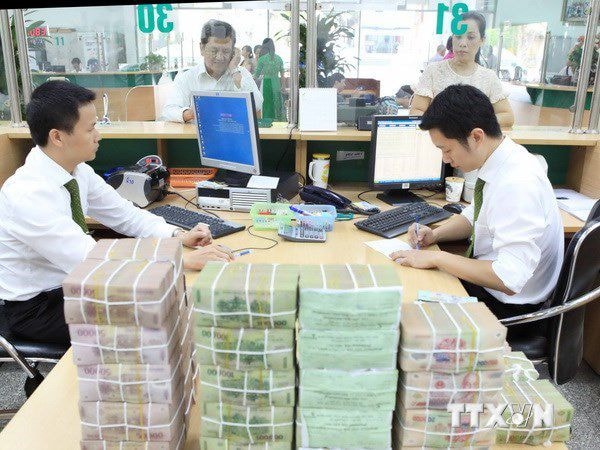Reducing state budget deficit
(Baonghean) - Fiscal policy and state budget deficit play a very important role, closely linked to the implementation of the country's socio-economic development strategy. To basically keep the state budget deficit in line with the estimate, or even lower than the estimate, even though state budget revenue and expenditure exceed the estimate, it requires a lot of effort from all levels of budget users, and especially depends on domestic and foreign loans... This makes the Vietnamese state budget facing a "spiral" of debt with the scale of government debt increasingly large.
Public debt ratio remains high
According to the Ministry of Finance, public debt is currently increasing rapidly, from 51.7% of GDP in 2010 to 60.3% of GDP by the end of 2014 and is estimated to be about 64% of GDP by the end of 2015 before reaching its peak of 64.9% of GDP in 2016, gradually decreasing in the following years until 2020 to about 60.2% of GDP. The proportion of domestic loans increased from 40.3% of total loans in 2010 to 54.5% in 2014.
 |
| Illustration photo - Internet |
According to the Ministry of Finance, the absolute figures of public debt in recent years have tended to increase. However, if taking into account two important factors: public debt structure and debt repayment capacity, Vietnam's public debt is still within the safe threshold approved by the National Assembly and the Government.
Regarding loan guarantees, by the end of 2013, the total number of projects granted foreign loan guarantees was 104, of which 23 projects had completed debt repayment, while 81 projects were still in the guarantee stage. The total amount of foreign loans guaranteed by the Government disbursed in 2013 was 52,340 billion VND, an increase of 10% compared to 2012. The total value of loans guaranteed by the Government is on a rapid increase trend, each year higher than the previous year and reaching an average increase of nearly 50%/year.
Debt obligations are increasingly burdensome.
According to the 2014 plan, the amount of public debt payment is up to 208,883 billion VND, accounting for nearly 21% of total expenditure, equivalent to 26.7% of total budget revenue according to the 2014 estimate. The Government's debt payment portion in the 2013 budget balance is estimated at 103,700 billion VND, which according to the Government is still within the prescribed limit of Vietnam, which is below 25% of state budget revenue and within the safe limit according to international practice. Most recently, the Ministry of Finance said that in the first 9 months of 2015, the total volume of newly issued government bonds reached nearly 127.5 trillion VND, equal to 51% of the plan. Of which, the 5-year term is more than 64 trillion VND, the 10-year term or more is more than 63.4 trillion VND, and the 20-year term alone is 4,230 billion VND. Meanwhile, the volume of principal and interest payments on government bonds in the first 9 months was nearly 160.7 trillion VND. Thus, the volume of newly mobilized capital was not enough to pay off the principal and interest on due debt, with a deficit of more than 33.2 trillion VND.
Must switch to budget surplus
According to Dr. Vu Dinh Anh, it is clear that Vietnam's ability to repay public debt is related to a series of economic and financial factors, in which the State budget factor plays a particularly important role. That is the reality that the public debt situation and the ability to repay debt cannot improve if the State budget deficit continues to remain at a high level, with no prospect of narrowing, stopping and switching to a budget surplus. Second, borrowing new debt to repay old debt (debt rollover) is an inevitable consequence of not having a source to repay debt, causing the scale of accumulated debt to increase, inevitably leading to a debt crisis. Third, the source to offset the State budget deficit shifts from foreign loans to domestic loans in the context of the domestic financial market, which potentially has many risks, such as risks of maturity, interest rates, high bad debt ratio and the safety and soundness of the financial system, which will affect the ability to borrow and repay public debt.
 |
| Vietnam's trade deficit in 2015 is forecast to be about 6 billion USD. Illustrative photo |
In addition, the fact that principal repayments often exceed estimates while interest repayments are often lower than the State budget estimates not only demonstrates limitations in budgeting, but also shows that debt management is inadequate and limited. Risks in exchange rates, the ability to borrow new debt to repay old debt, interest rate fluctuations, etc. have not been well managed. In addition, the sharp increase in the scale of loans for re-lending and the rapid increase in investment expenditures from the Government bond source in the context of ineffective management of loan capital use and state investment management, with a large rate of loss and waste, will reduce the ability to repay debt both directly from projects using public debt capital and indirectly from the impact on economic growth of these investment projects - Dr. Vu Dinh Anh further analyzed.
In general, Vietnam's state budget expenditure has been at a very high level, so although state budget revenue has increased sharply, the state budget deficit has not decreased, but has even increased. To balance the state budget, reduce the state budget deficit and reduce public debt, it is not only possible to continue to increase state budget revenue but also to reduce state budget expenditure. Moreover, state budget expenditure discipline needs to be strengthened to end the situation of spending exceeding the estimate while the state budget estimate already has a contingency expenditure and financial reserves.
Red River
| RELATED NEWS |
|---|

